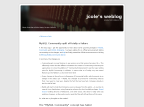March 2008

Mark's IT Blog: How to Hire a Great MySQL DBA
(via)
Ivan Zoratti's Blog (on MySQL): Meetup Group and Thoughts on MySQL Proxy
(via)
Design details of Audiogalaxy.com’s high performance MySQL search engine | Spiteful.com
(via)February 2008

TagSchema - MySQLForge Wiki
by 2 others (via)January 2008

MySQL Swiss Army Knife | lefred's blog
by 3 others (via)November 2007

jcole’s weblog: Jeremy Cole’s take on life. » Blog Archive » On Hiring a MySQL DBA/Architect
(via)August 2007

GreenSQL - Open Source Database Firewall Solution
by 4 others
The open-source community's double standard on MySQL | The Open Road - CNET Blogs
(via)
MySQL Community split officially a failure

Download | Community MySQL Builds

Target Practice - A Workshop in Tuning MySQL Queries - Jay Pipes
(via)
MySQL Performance Blog » Landscape of Transactional Storage Engines for MySQL
(via)July 2007

Diamond Notes » Blog Archive » Fantastic New Tool!!!!!
(via)Mark's IT Blog: MySQL 5 High Availability with DRBD 8 and Heartbeat 2
(via)June 2007
MySQL and the The Death of RAID « Kevin Burton’s NEW FeedBlog
(via)April 2007
Google Code - Updates: Google releases patches that enhance the manageability and reliability of MySQL
by 1 other (via)March 2007

Introducing MySQL Table Sync - Xaprb
(via)February 2007

SourceForge.net: MySQL Toolkit
by 2 others (via)January 2007

MySQL AB :: Managing Hierarchical Data in MySQL
by 13 others (via)
How to make MySQL replication reliable - Xaprb
by 1 other
MySQL: Storing Passwords in MySQL
by 2 others (via)


